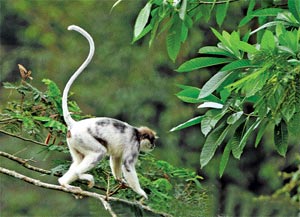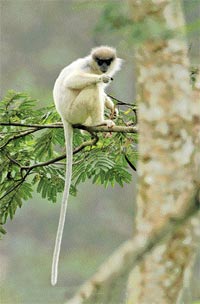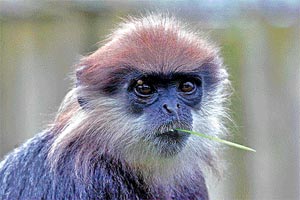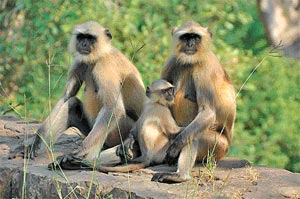Leaping snowballs!
White langurs of Sinharaja:
 Interested
in seeing a rare species of monkey? Then the next time you visit the
virgin forests of Sinharaja, one of nature's most wonderful gifts to our
little country, watch out for these leaping snowballs. You can certainly
consider yourself fortunate if you do spot even a single one of them
because they are veterans at playing hide and seek.To see a white langur
leaping in the canopy of the Sinharaja Forest Reserve would be an
experience as exhillerating as spotting a leopard in the wilderness of
Wilpattu or Yala. These new white monkeys are certainly harder to spot
than the leopards, as it has been proven by the fact that they have
virtually stayed hidden all this time. Interested
in seeing a rare species of monkey? Then the next time you visit the
virgin forests of Sinharaja, one of nature's most wonderful gifts to our
little country, watch out for these leaping snowballs. You can certainly
consider yourself fortunate if you do spot even a single one of them
because they are veterans at playing hide and seek.To see a white langur
leaping in the canopy of the Sinharaja Forest Reserve would be an
experience as exhillerating as spotting a leopard in the wilderness of
Wilpattu or Yala. These new white monkeys are certainly harder to spot
than the leopards, as it has been proven by the fact that they have
virtually stayed hidden all this time.
|

The new species discovered recently in the Sinharaja Forest - |
The discovery of this new species of monkey by the primate research
team of the Wildlife Conservation Society, Galle (WCSG)) recently
further establishes the rich biodiversity of the World Heritage Site,
the Sinharaja Forest and the urgent need to conserve this unique
biosphere.
On a tip off from the villagers in the vicinity, the WCSG team
engaged in conducting research on the Southern Purple Face Leaf Langur (Semnopithecus
vetulus vetulus) also known as the purple-faced leaf monkey, in the area
had made great efforts to trace this rare species.
The new species of white langur is believed to be a different colour
morph to the endemic Purple-faced Leaf Monkey known which is popularly
referred to as the '˜Kalu wandura' in Sinhala .And the research team had
finally spotted about 30 individuals from 14 monkey troops they had
studied in this area. All have been recorded within an 18 km stretch in
and around the lesser explored areas of the Sinharaja Rain forest
environs .
According to reports, the President of WCSG, Madura De Silva has
claimed that this colour morph named the Galanthus is a snow-white
colour variant of the endemic Purple-faced Leaf Monkey. Some of these
monkeys are said to be completely white while others have mixed coats.
However, it has been observed that the babies of some of the white
mothers are black while vice versa in the wild.
This is the first time that this rare species of ghost-like white
monkeys have been captured on camera even though mention of their
existence had been made
 as
far back as in the1680s and 1860s.Both Robert Knox and Sir Emerson
Tennent have made reference to these monkeys in their literary works;
Seeing Ceylon( 1681 -Robert Knox) and The Natural History of Ceylon
(1861- Sir Emerson Tennent ). Just like Sir Emerson Tennent who had been
amazed by the striking white coat of this monkey he had seen during his
time here and initially thought it to be an albino but later ruled it
out on seeing the colour of its eyes and face, the WCSG researchers too
had initially thought the new white species of monkeys were albinos. as
far back as in the1680s and 1860s.Both Robert Knox and Sir Emerson
Tennent have made reference to these monkeys in their literary works;
Seeing Ceylon( 1681 -Robert Knox) and The Natural History of Ceylon
(1861- Sir Emerson Tennent ). Just like Sir Emerson Tennent who had been
amazed by the striking white coat of this monkey he had seen during his
time here and initially thought it to be an albino but later ruled it
out on seeing the colour of its eyes and face, the WCSG researchers too
had initially thought the new white species of monkeys were albinos.
However, they too confirm the fact that the monkeys are not albinos
as none have red eyes. All have black naked parts of the face and beige
to ashy brown crown hair, observed these researchers.
According to the reputed environmentalist Rohan Pethiyagoda, the new
colour morph is due to a phenomena known as leucism ,a condition
characterised by reduced pigmentation in animals that gives colour to
their skin and fur. Unlike in the case of albinism, which is the
reduction of a skin pigment melanin, in the case of leucism a reduction
in all types of skin pigments occur. And as their white coats are very
conspicuous in the green canopy, the possibilities of these animals
being preyed upon are very high.
These beautiful snow white langurs are indeed a great discovery.It is
not only important to carry out extensive research on this rare species
but also take stringent measures to protect and conserve them as
national treasures.
Purple -faced langur
 The
purple-faced langur (Trachypithecus vetulus), or purple-faced leaf
monkey, is a species of Old World monkey endemic to Sri Lanka.The
endemic Purple-faced Langur is the commonest larger mammal in Sinharaja
Forest Reserve, located in Sabaragamuwa and Southern Provinces of Sri
Lanka. The
purple-faced langur (Trachypithecus vetulus), or purple-faced leaf
monkey, is a species of Old World monkey endemic to Sri Lanka.The
endemic Purple-faced Langur is the commonest larger mammal in Sinharaja
Forest Reserve, located in Sabaragamuwa and Southern Provinces of Sri
Lanka.
This is a long-tailed arboreal species, mainly brown with a dark
facemask and paler lower face. Its loud barking call, particularly of
the highland form,is often mistaken for the roar a leopard.Once a common
species, which was found even in suburban Colombo and in the wet zone
villages, today its numbers have dwindled due to urbanisation. They are
now mostly confined to Sinharaja, Kitulgala, the mountains at Horton
Plains National Park or in the rainforest city of Galle.This species is
very selective in its diet,
There are four distinct subspecies of purple-faced langur:
* Southern lowland wetzone purple-faced langur, Trachypithecus
vetulus vetulus
* Western purple-faced langur or North Lowland Wetzone Purple-faced
Langur, Trachypithecus vetulus nestor
* Dryzone purple-faced langur, Trachypithecus vetulus philbricki
* Montane purple-faced langur or Bear Monkey, Trachypithecus vetulus
monticola
The western purple-faced langur (Trachypithecus vetulus nestor), is
endemic to Sri Lanka. Found mostly in the wet zone in western Sri Lanka
the subspecies is generally gray-brown in colour with lighter whiskers,
a gray rump patch, and dark forearms and legs.The langur has a body
length between 48 and 67 centimetres (19 and 26 in) and a tail tail, 59
to 85 centimetres (23 to 33 in) long. On average, males weigh 8.5
kilograms (19 lb) and females weigh 7.8 kilograms (17 lb).
A drastic decline in the population,( over 80 per cent ) had been
recorded in the species over the last 65 years and the International
Union for Conservation of Nature (IUCN) had declared the western purple
-faced langur a critically endangered species since 2004.
Deforestation and loss of habitat has led these arboreal ( tree
dwelling) monkeys which are naturally folivorous (leaf eating) animals
to not only depend on fruits which are seasonal for its diet but also
spend more time on the ground foraging for food .They venture into home
gardens and climb power exposing themselves to a lot of danger.
What are langurs?
Langurs are members of the primate family Cercopitecidae with 13
species represented in the genus Semnopithecus.These monkeys which
represent one of the
 most
diverse groups of colobine monkeys in Asia are generally identified by
the colour of their fur coats and vocalizations. The langurs have fur
coats ranging from silver grey to glossy black, a glistening gold most
diverse groups of colobine monkeys in Asia are generally identified by
the colour of their fur coats and vocalizations. The langurs have fur
coats ranging from silver grey to glossy black, a glistening gold
as well as brownish depending on the species and area. A raised brow
crest is common among most of these species and they are known to use
this to communicate messages of anger or pleasure to other meembers
.Most species measure from 16-32 in (40-80 cm) and have a body weight
ranging from 11-53 lb (5-24 kg), with most species weighing around 13-18
lb (6-8 kg).

They also have long limbs and tails; the tail length of the Hanuman
langur can reach up to 43 in (108 cm) .However, the tails are not
prehensile(moveable) like those of South American monkeys.
These monkeys which are extremely agile are mostly arboreal (tree
dwelling), leaf-eating species. However, some species could be spotted
spending a lot of time on the ground, foraging for food.You may be
amazed to learn about their diet. Researchers label most of these
monkeys as opportunistic feeders,because they would eat insects, fungi,
and fruit when they get a chance to do so.
There are some species which also eat small amounts of soil, most
probably for its mineral content. Then species, such as the Hanuman
langur eat sap and gum and even large quantities of certain fruit with
high strychnine content that could kill other species.
 The
langurs live in troops but their social behaviour varies considerably
according to species as well as to age, sex, and ecological conditions.
Females rarely leave the troop. Males, in contrast, leave shortly before
they reach sexual maturity, at about three years of age.Not all langur
or leaf monkey troops are as large as those of the Hanuman langur. The
langurs live in troops but their social behaviour varies considerably
according to species as well as to age, sex, and ecological conditions.
Females rarely leave the troop. Males, in contrast, leave shortly before
they reach sexual maturity, at about three years of age.Not all langur
or leaf monkey troops are as large as those of the Hanuman langur.
Not only the size of the troops but also the size of their individual
territories too differ according to the habitat and the availability of
food. Large troops of Hanuman langurs, for example, may have a home
range of more than 2,400 acres (1,000 ha), but this is an extreme case.
Young langurs learn to recognize their own mothers shortly after
birth, which is important in a society where any curious arms reach out
to touch and hold a newborn infant.. Mothers may even suckle offspring
that are not their own. When they are weaned, young langurs usually
retain some association with their mothers, even though she may by now
have additional offspring. Young females, in particular, often assist
the mother with bringing up her young.
Fast facts
* The Wildlife Conservation Society of Galle (WCSG) was established
in 1993 in collaboration with the Maritime Museum of Galle. The society
is registered in the Central Environmental Authority .The President is
Madura De Silva
* The hilly virgin Sinharajah rain forest, part of the Sri Lanka
lowland rain forests eco -region, was saved from the worst of commercial
logging by its inaccessibility, and was designated a World Biosphere
Reserve in 1978 and a World Heritage Site in 1988. It is also a World
Heritage Site by UNESCO
*The best known Asian leaf-eating monkey species is probably the
Hanuman Langur or Gray Langur , considered sacred by the Hindus of
India.The Hanuman langur (Semnopithecus entellus),has a silver-grey
coat.The Ebony leaf monkey (S. auratus) from Vietnam and Indonesia has
glossy black fur ,the golden leaf monkey (S. geei) has a glistening
orange coloured coat and black face while the elegantly patterned
purple-faced leaf monkey (S. vetulus) of Sri Lanka, has a brownish coat,
a ruby face and a distinct white-yellow throat patch.
* Prior to 2004 the western purple-faced langur which is endemic to
Sri Lanka was listed as "endangered", but not "critically endangered".
In 2010, it was included in the list of The World's 25 Most Endangered
Primates, published by the IUCN and other organizations
*The Asian langurs belong to the family Cercopithecidae and subfamily
Colobinae, or leaf-eating monkeys. Leaf monkeys have large stomachs that
are divided into a number of sacs, like those of ruminants such as
cattle and deer. (The other major group in the subfamily colobinae are
the African colobus monkeys, which share similar diets but are found
only in Africa.)
*The Gray Langur is the most common monkey found in South Asia with
approximately 300,000 existing today. The seven subspecies of this
monkey are the Nepal, Kashmir, Tarai, Northern Plains, Black-footed,
Southern Plains and the Tufted Gray Langur. Grey langur and purple faced
langur are found in Sri Lanka.
Courtesy: Internet |

